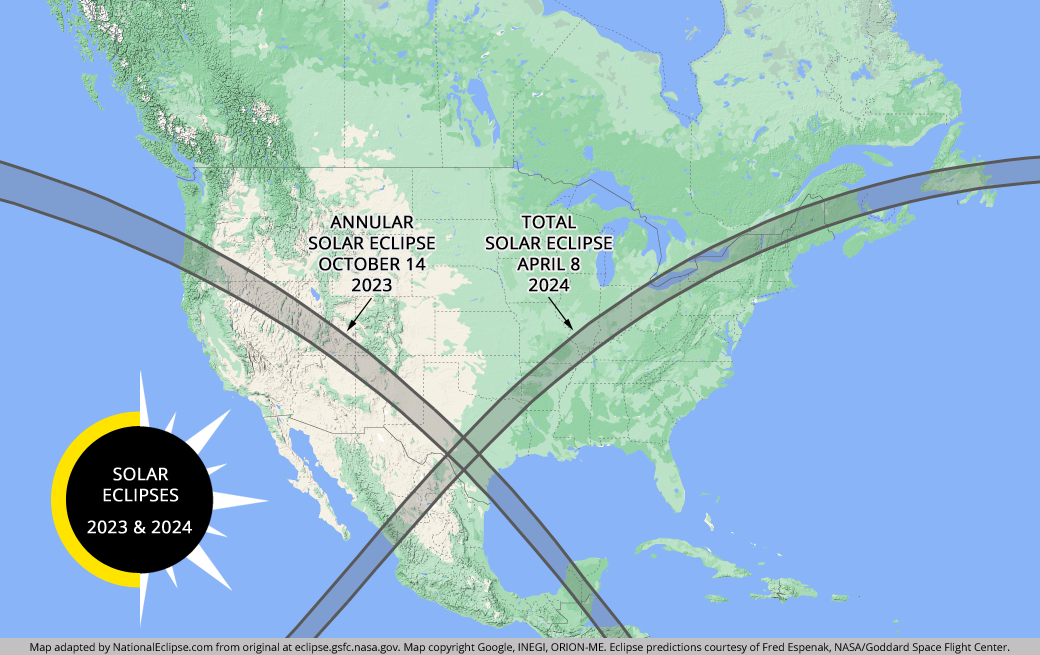NationalEclipse.com | Sep 14, 2023 | National Eclipse Blog

We're now less than one month away from the next solar eclipse in America. On October 14, 2023, an annular, or "ring of fire," solar eclipse will cross over eight U.S. states. This eclipse can serve as a "dry run" of sorts for the highly anticipated total solar eclipse that will occur less than six months later on April 8, 2024. But what exactly is an annular solar eclipse and how is it different from a total solar eclipse?
An annular solar eclipse occurs when the Moon passes directly between the Earth and the Sun but the Moon is too far away from the Earth to completely obscure the Sun. This happens because the Moon's distance from the Earth varies during its monthly elliptical orbit around our planet. Sometimes it's closer to the Earth in its orbit and sometimes it's farther away. If a solar eclipse happens to occur when the Moon is at or near its farthest point from the Earth, called apogee, we get an annular solar eclipse instead of a total solar eclipse.
Unlike during a total solar eclipse, when the Moon obscures the entire bright surface of the Sun, the outer edge of the solar disc remains visible during an annular solar eclipse. Instead of the "totality" of a total solar eclipse, when the day turns dark and only the pearlescent outer atmosphere of the Sun remains visible, an annular solar eclipse results in what looks like a "ring of fire" in the sky.
In fact, that's where this type of eclipse gets its name. Although some people mistakenly refer to an annular solar eclipse as an annual solar eclipse, the correct word annular is derived from the Latin word anulus or annulus, meaning "ring."
If you think about it, an annular solar eclipse should rightfully be a total solar eclipse. The alignment of Sun-Moon-Earth is perfect. The only problem is that the Moon doesn't want to fully cooperate and is too far away to completely cover the Sun from our vantage point on Earth. Statistically, annular solar eclipses occur just about as frequently as total solar eclipses, give or take. If not for the fact that the Moon's orbit around the Earth is elliptical, we Earthlings would enjoy twice as many total solar eclipses as we actually do.
Because the Moon never entirely covers the Sun during an annular solar eclipse, you must use special eclipse safety glasses or viewers at all times. Unlike during a total solar eclipse, when it's safe to remove your eclipse glasses during the very brief period of "totality" when the Sun is 100 percent blocked by the Moon, there is never a time during an annular solar eclipse when it's safe to look with unprotected eyes.
As is the case with a total solar eclipse, which traces a "path of totality" across the Earth, an annular solar eclipse has a path too. We call it a "path of annularity." In the same way that you need to be inside the path of totality to see totality during a total solar eclipse, you need to be inside the path of annularity to see annularity during an annular solar eclipse. If you're outside the path of annularity, the Moon won't line up perfectly with the Sun and you won't see the perfect "ring of fire" in the sky.
The upcoming annular solar eclipse on October 14, 2023, will carve a narrow path of annularity from northwest to southeast across eight U.S. states—Oregon, California, Nevada, Utah, Arizona, Colorado, New Mexico, and Texas. While the total eclipse occurring six months later on April 8, 2024, runs from Texas to Maine, this annular eclipse is more of a western affair.

In fact, although nobody will ever claim that an annular solar eclipse is more impressive than a total solar eclipse, this one in particular does have the advantage of crossing over some truly stunning landscapes in the American West. On October 14, the ring of fire will be seen over a plethora of national parks and monuments, including Crater Lake National Park, Bryce Canyon National Park, Capitol Reef National Park, Canyonlands National Park, Natural Bridges National Monument, Mesa Verde National Park, and others. It also crosses over the world famous Monument Valley area along the Utah-Arizona border. When taken together with the landscapes it will cross over, this annular eclipse might actually surpass the visual appeal of the total eclipse six months later, especially as professional photographers are concerned.
Although they certainly don't generate the buzz and excitement of total solar eclipses, annulars are generally considered the next best thing. And since eclipse fever is already in the air for the April 2024 total, the October 2023 annular will definitely garner more enthusiasm than usual. Just remember that an annular solar eclipse will never come anywhere near the splendor and magnificence of a total solar eclipse. If you live in the path of annularity or you're planning a trip there for October 14, don't allow the lesser experience of an annular eclipse to discourage you from seeing the total eclipse six months later. Enjoy the annular eclipse for what it is, use it to practice your eclipse-day preparations, and then get ready six months later to really have your mind blown.